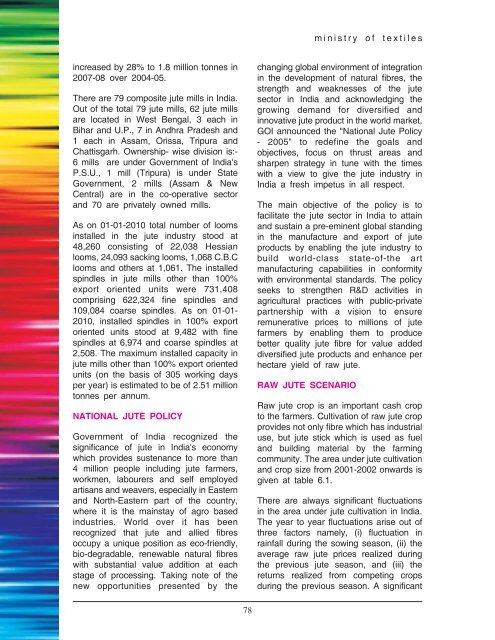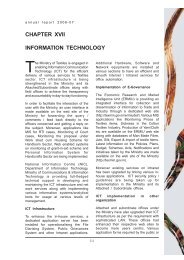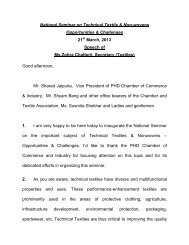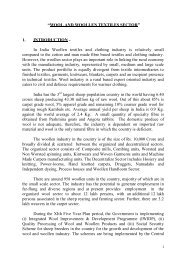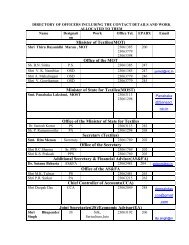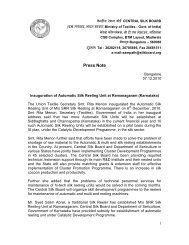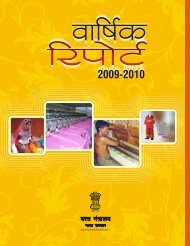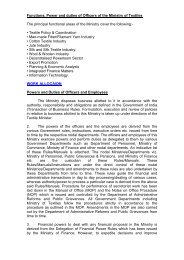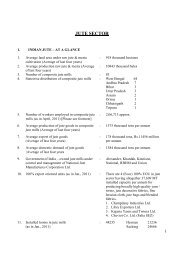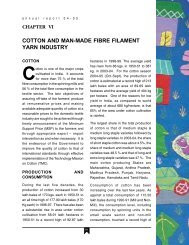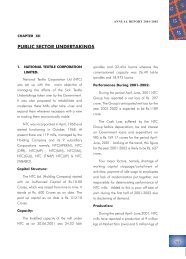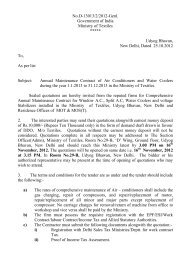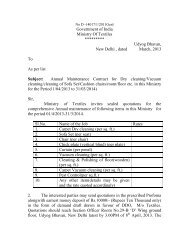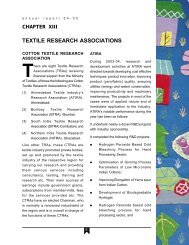Create successful ePaper yourself
Turn your PDF publications into a flip-book with our unique Google optimized e-Paper software.
ministry <strong>of</strong> textilesincreased by 28% to 1.8 million tonnes in2007-08 over 2004-05.There are 79 composite jute mills in India.Out <strong>of</strong> the total 79 jute mills, 62 jute millsare located in West Bengal, 3 each inBihar and U.P., 7 in Andhra Pradesh and1 each in Assam, Orissa, Tripura andChattisgarh. Ownership- wise division is:-6 mills are under Government <strong>of</strong> India'sP.S.U., 1 mill (Tripura) is under StateGovernment, 2 mills (Assam & NewCentral) are in the co-operative sectorand 70 are privately owned mills.As on 01-01-2010 total number <strong>of</strong> loomsinstalled in the jute industry stood at48,260 consisting <strong>of</strong> 22,038 Hessianlooms, 24,093 sacking looms, 1,068 C.B.Clooms and others at 1,061. The installedspindles in jute mills other than 100%export oriented units were 731,408comprising 622,324 fine spindles and109,084 coarse spindles. As on 01-01-2010, installed spindles in 100% exportoriented units stood at 9,482 with finespindles at 6,974 and coarse spindles at2,508. The maximum installed capacity injute mills other than 100% export orientedunits (on the basis <strong>of</strong> 305 working daysper year) is estimated to be <strong>of</strong> 2.51 milliontonnes per annum.NATIONAL JUTE POLICYGovernment <strong>of</strong> India recognized thesignificance <strong>of</strong> jute in India's economywhich provides sustenance to more than4 million people including jute farmers,workmen, labourers and self employedartisans and weavers, especially in Easternand North-Eastern part <strong>of</strong> the country,where it is the mainstay <strong>of</strong> agro basedindustries. World over it has beenrecognized that jute and allied fibresoccupy a unique position as eco-friendly,bio-degradable, renewable natural fibreswith substantial value addition at eachstage <strong>of</strong> processing. Taking note <strong>of</strong> thenew opportunities presented by thechanging global environment <strong>of</strong> integrationin the development <strong>of</strong> natural fibres, thestrength and weaknesses <strong>of</strong> the jutesector in India and acknowledging thegrowing demand for diversified andinnovative jute product in the world market,GOI announced the "National Jute Policy- 2005" to redefine the goals andobjectives, focus on thrust areas andsharpen strategy in tune with the timeswith a view to give the jute industry inIndia a fresh impetus in all respect.The main objective <strong>of</strong> the policy is t<strong>of</strong>acilitate the jute sector in India to attainand sustain a pre-eminent global standingin the manufacture and export <strong>of</strong> juteproducts by enabling the jute industry tobuild world-class state-<strong>of</strong>-the artmanufacturing capabilities in conformitywith environmental standards. The policyseeks to strengthen R&D activities inagricultural practices with public-privatepartnership with a vision to ensureremunerative prices to millions <strong>of</strong> jutefarmers by enabling them to producebetter quality jute fibre for value addeddiversified jute products and enhance perhectare yield <strong>of</strong> raw jute.RAW JUTE SCENARIORaw jute crop is an important cash cropto the farmers. Cultivation <strong>of</strong> raw jute cropprovides not only fibre which has industrialuse, but jute stick which is used as fueland building material by the farmingcommunity. The area under jute cultivationand crop size from 2001-2002 onwards isgiven at table 6.1.There are always significant fluctuationsin the area under jute cultivation in India.The year to year fluctuations arise out <strong>of</strong>three factors namely, (i) fluctuation inrainfall during the sowing season, (ii) theaverage raw jute prices realized duringthe previous jute season, and (iii) thereturns realized from competing cropsduring the previous season. A significant78


